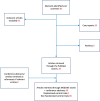Anatomical Variations of the Sinonasal Area and Their Clinical Impact on Sinus Pathology: A Systematic Review
- PMID: 35846811
- PMCID: PMC9282972
- DOI: 10.1055/s-0042-1742327
Anatomical Variations of the Sinonasal Area and Their Clinical Impact on Sinus Pathology: A Systematic Review
Abstract
Introduction Anatomical variations of the nasal cavity and of the paranasal sinuses are frequently encountered and play an important role in dysfunctional drainage of sinuses. However, it is not clear in the literature whether they predispose to sinus pathology. Objectives The aim of the present review is to summarize the understanding of the association between anatomical variations of the sinonasal area and sinus pathology. Data Synthesis The present review was conducted according to the Preferred Reporting Items for Systematic Reviews and Meta-Analysis (PRISMA) guidelines. We performed a thorough research on PubMed from October 2004 until May 2020 by using the search terms paranasal sinus anatomical variations and sinus disease , sinusitis , and mucosal disease . Thirty studies were eligible and were included in the analysis. Overall, the studies encompassed a total of 6,999 patients included in the present review. In many studies, it has been statistically established that certain anatomical variations increase the risk of sinus disease. On the other hand, the rest of the collected studies failed to show any statistically significant correlation between anatomical variants and sinus pathology. Conclusion The present study highlights the possible correlation between some anatomical variations of the sinonasal area and pathologies of the paranasal sinuses. Careful assessment and computed tomography (CT) in patients with chronic rhinosinusitis is needed, especially in those undergoing endoscopic surgery, to identify and treat anatomical variations in the paranasal sinuses that may be correlated with rhinosinusitis. Due to contradictory results in the literature, further research is needed to elucidate the effects of anatomical variants of the sinonasal area.
Keywords: anatomical variations; nasal cavity; paranasal sinuses; sinus pathology.
Fundação Otorrinolaringologia. This is an open access article published by Thieme under the terms of the Creative Commons Attribution-NonDerivative-NonCommercial License, permitting copying and reproduction so long as the original work is given appropriate credit. Contents may not be used for commecial purposes, or adapted, remixed, transformed or built upon. ( https://creativecommons.org/licenses/by-nc-nd/4.0/ ).
Conflict of interest statement
Conflict of Interests The authors have no conflict of interests to declare.
References
-
- Kaya M, Çankal F, Gumusok M, Apaydin N, Tekdemir I. Role of anatomic variations of paranasal sinuses on the prevalence of sinusitis: Computed tomography findings of 350 patients. Niger J Clin Pract. 2017;20(11):1481–1488. - PubMed
-
- Kaygusuz A, Haksever M, Akduman D, Aslan S, Sayar Z. Sinonasal anatomical variations: their relationship with chronic rhinosinusitis and effect on the severity of disease-a computerized tomography assisted anatomical and clinical study. Indian J Otolaryngol Head Neck Surg. 2014;66(03):260–266. - PMC - PubMed
-
- Cho J H, Park M S, Chung Y S, Hong S C, Kwon K H, Kim J K. Do anatomic variations of the middle turbinate have an effect on nasal septal deviation or paranasal sinusitis? Ann Otol Rhinol Laryngol. 2011;120(09):569–574. - PubMed
-
- Langille M, Walters E, Dziegielewski P T, Kotylak T, Wright E D. Frontal sinus cells: identification, prevalence, and association with frontal sinus mucosal thickening. Am J Rhinol Allergy. 2012;26(03):e107–e110. - PubMed
Publication types
LinkOut - more resources
Full Text Sources


